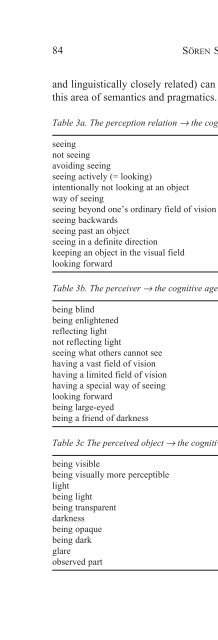Cognitive Semantics : Meaning and Cognition
Cognitive Semantics : Meaning and Cognition
Cognitive Semantics : Meaning and Cognition
You also want an ePaper? Increase the reach of your titles
YUMPU automatically turns print PDFs into web optimized ePapers that Google loves.
SITUATED EMBODIED SEMANTICS AND CONNECTIONIST MODELING 177<br />
• Is it possible to achieve adequate linguistic categorization of situations,<br />
without any explicit (symbolic) “semantic representations”?<br />
• What kind of pre-structuring (i.e., “innate bias”) is required for this to<br />
be achieved?<br />
These two questions will be the primary focus of the remaining part of this<br />
paper. I will deal with them in the context of a concrete connectionist model<br />
described in the following section.<br />
3. Experimenting with Regier’s system<br />
Regier’s (1992) system, graphically presented in Figure 1, is a feed-forward<br />
structured connectionist net, using the backpropagation learning rule<br />
(Rumelhart et al. 1986). It takes perceptual input from its environment,<br />
processes it within a number of internal modules, <strong>and</strong> “learns” to associate the<br />
perceptual scenes with one or more output nodes by comparing the actual<br />
output with an externally given “correct” output <strong>and</strong> gradually minimizing the<br />
discrepancy.<br />
The environment the system interacts with is one of 2-dimensional geometric<br />
objects. The first major simplification with respect to embodiment is<br />
that this interaction takes the form of perception only, with no motor activity<br />
whatsoever. A second simplification is that the system “sees” only 2 objects at<br />
a time <strong>and</strong> furthermore, in order to avoid the empiricist problem of deciding<br />
which object is being related to which, one of the objects is explicitly labeled<br />
trajector (TR) <strong>and</strong> the other l<strong>and</strong>mark (LM), in correspondence with the<br />
terminology from cognitive linguistics. 2 A third simplification is the way<br />
situations in which there is motion are dealt with: as a sequence of “snapshots”<br />
or “frames” during which the l<strong>and</strong>mark remains static, while the trajector<br />
varies its position with respect to it. A static scene is a special case where the<br />
frames in the sequence are identical. Regier refers to each of these sequences<br />
as a “movie”. I will be using the more general term situation since, despite<br />
limitations such as the above, I will be using the model as an (impoverished)<br />
illustration of the situated embodied approach.<br />
The internal modules contain considerable pre-structuring, which I do<br />
not intend to describe here, but it should be noted that their purpose is to<br />
extract relatively high-level perceptual features such as contact, inclusion,















